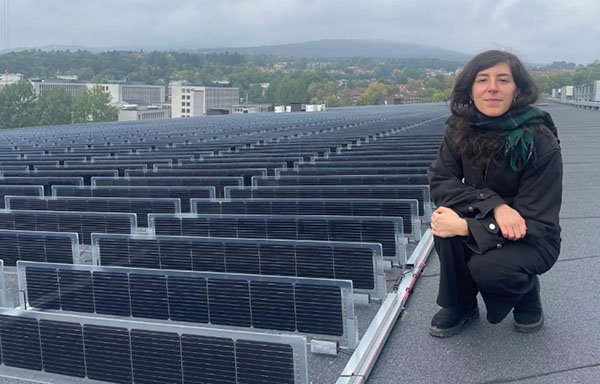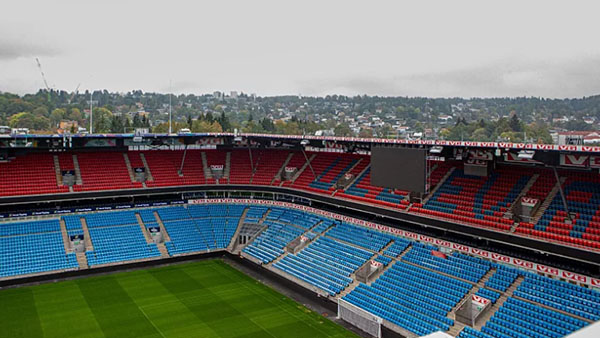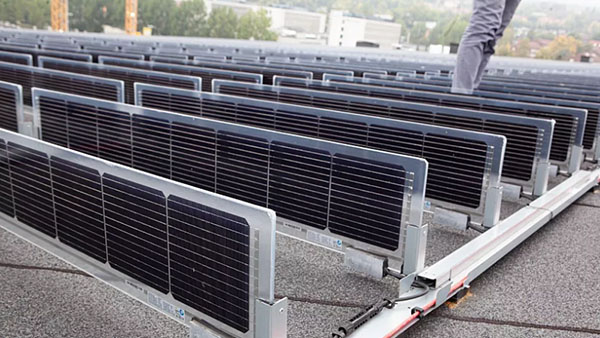- English
- Español
- Português
- русский
- Français
- 日本語
- Deutsch
- tiếng Việt
- Italiano
- Nederlands
- ภาษาไทย
- Polski
- 한국어
- Svenska
- magyar
- Malay
- বাংলা ভাষার
- Dansk
- Suomi
- हिन्दी
- Pilipino
- Türkçe
- Gaeilge
- العربية
- Indonesia
- Norsk
- تمل
- český
- ελληνικά
- український
- Javanese
- فارسی
- தமிழ்
- తెలుగు
- नेपाली
- Burmese
- български
- ລາວ
- Latine
- Қазақша
- Euskal
- Azərbaycan
- Slovenský jazyk
- Македонски
- Lietuvos
- Eesti Keel
- Română
- Slovenski
- मराठी
- Srpski језик
The world's largest vertical solar roof
2024-10-29
Egret Solar has launched the vertical solar panel mounting system last year, and we have gained many customers in many countries. You must have been interested how dose it work,today let`s take a look the world`s largest vertical solar roof in Norway.
Vertical solar panels are proving to be a new solution for northern regions, yielding 20 per cent more energy than traditional panels.
Norway’s national football stadium carries a lesser-known star attraction: 1,242 solar panels stretching across the roof.
These are not traditional flat roof panels. The mini, square-shaped solar panels have two key features that distinguish them from those typically seen on buildings: they are bifacial, meaning they have two active sides, and they are installed vertically.
In June 2024, Ullevaal Stadium in Oslo became home to the world’s largest vertical solar panel installation on a roof, placing the stadium at the forefront of renewable energy innovation.
At first glance, the panels look fragile, and one might worry about stepping on them. But during a visit to the stadium, we quickly learn that they are incredibly efficient in generating solar power.

What is the difference between vertical and horizontal solar panels?
It might seem counterintuitive not to tilt solar panels to face the sun directly, as installations are usually angled to align with the latitude in which buildings are located. However, recent studies show that bifacial vertical photovoltaic (PV) panels can outperform traditional models in terms of energy generation.
Scientists at the Dutch research organisation TNO examined why this is the case. It’s not because bifacial solar panels have two identical but opposite sides, but because traditional tilted PV panels tend to overheat when the sunlight is too strong.
“Lower operating temperatures correspond to increased performance,” explains Bas van Aken, a scientist at TNO.
“PV panels lose about 1 per cent of performance for every 2 to 3 degrees Celsius they warm up. Tilted roof PV systems can easily heat up by 50 degrees, while open-field PV systems see panels getting up to 25 to 30 degrees warmer than the ambient air,” he adds.
Vertical solar panels can yield up to 20 per cent more energy, making them valuable in climates with harsh and dark winters, where maximising energy production during shorter days is crucial.

At Ullevaal Stadium, the panels face the sun directly, with its PV system oriented north-south to capture light during peak times in the early afternoon. “We chose this orientation because we want to produce more energy in winter when electricity prices are higher,” says Lise Kristin Sunsby, the stadium’s real estate manager.
These panels can also be combined with green roofs, which help cities absorb CO2 and become more environmentally friendly - a feature that is not possible with tilted panels. In Germany, solar balconies - small panels installed on apartment terraces - are becoming popular as a way to offset individual energy consumption.

According to the European Commission, integrating this technology can further help Europe fix its energy price swings and provide more energy security.
However, vertical PV is not part of a ‘winner takes all race’. Mongstad suggests that there will not be a switch from horizontal to vertical PVs any time soon; this change is more likely to occur when older installations reach the end of their lifecycle, at which point companies could replace the old panels with vertical ones.
Only a mix of inclinations - from vertical to horizontal, and orientations from east to west and south to north - will help generate constant energy throughout the day and further stabilise energy prices across the continent.




